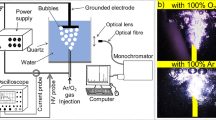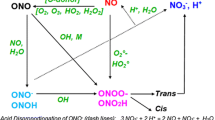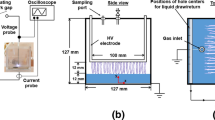Abstract
Plasma in- or in-contact-with liquid is an emerging technology that has high potential for use in liquid treatment applications. Due to the simultaneous production of highly reactive species, plasmas can efficiently eliminate pollutants that are difficult to remove using conventional methods. In this study, we investigate an AC-driven air plasma in contact with water, generated using five discharge modes. Modes 1, 2, and 3 are run at air-gap distance of 1, 3, and 3.5 mm, respectively, at a repetition rate of 10 kHz (sinusoidal waveform). Water polarity alternates between cathode and anode in modes 1 and 2, whereas mode 3 produces anode polarity only. Mode 4 is similar to mode 1, but with a repetition rate of 5 kHz, while mode 5 is similar to mode 3, but without the high-voltage preceding discharge when water is anode. The electrical characteristics of each discharge mode are presented in detail, and variations in water properties (namely water acidity and conductivity) are also discussed. The effect of discharge mode on the degradation rate of methylene blue (MB), a standard pollutant, is also investigated. Modes 1, 2, and 4 exhibit comparable MB degradation efficiencies, indicating insignificant dependence neither on air-gap distance or number of discharges. The difference between the efficiencies obtained using modes 3 and 5 suggests a substantial effect of the electric field applied between two successive discharges.










Similar content being viewed by others
References
Foster JE (2017) Plasma-based water purification: challenges and prospects for the future. Phys Plasmas 24(5):055501
Gadipelly C, Pérez-González A, Yadav GD, Ortiz I, Ibáñez R, Rathod VK, Marathe KV (2014) Pharmaceutical industry wastewater: review of the technologies for water treatment and reuse. Ind Eng Chem Res 53(29):11571–11592
Zhang J, Lee KH, Cui L, Jeong TS (2009) Degradation of methylene blue in aqueous solution by ozone-based processes. J Ind Eng Chem 15(2):185–189
Shimizu N, Ogino C, Dadjour MF, Murata T (2007) Sonocatalytic degradation of methylene blue with TiO2 pellets in water. Ultrason Sonochem 14(2):184–190
Houas A, Lachheb H, Ksibi M, Elaloui E, Guillard C, Herrmann JM (2001) Photocatalytic degradation pathway of methylene blue in water. Appl Catal B 31(2):145–157
Dutta K, Mukhopadhyay S, Bhattacharjee S, Chaudhuri B (2001) Chemical oxidation of methylene blue using a Fenton-like reaction. J Hazard Mater 84(1):57–71
Bruggeman PJ, Kushner MJ, Locke BR, Gardeniers JG, Graham WG, Graves DB et al (2016) Plasma–liquid interactions: a review and roadmap. Plasma Sources Sci Technol 25(5):053002
Bruggeman P, Leys C (2009) Non-thermal plasmas in and in contact with liquids. J Phys D Appl Phys 42(5):053001
Locke BR, Shih KY (2011) Review of the methods to form hydrogen peroxide in electrical discharge plasma with liquid water. Plasma Sources Sci Technol 20(3):034006
Joshi AA, Locke BR, Arce P, Finney WC (1995) Formation of hydroxyl radicals, hydrogen peroxide and aqueous electrons by pulsed streamer corona discharge in aqueous solution. J Hazard Mater 41(1):3–30
Ishijima T, Hotta H, Sugai H, Sato M (2007) Multibubble plasma production and solvent decomposition in water by slot-excited microwave discharge. Appl Phys Lett 91(12):121501
Brisset JL, Benstaali B, Moussa D, Fanmoe J, Njoyim-Tamungang E (2011) Acidity control of plasma-chemical oxidation: applications to dye removal, urban waste abatement and microbial inactivation. Plasma Sources Sci Technol 20(3):034021
Lu P, Boehm D, Bourke P, Cullen PJ (2017) Achieving reactive species specificity within plasma-activated water through selective generation using air spark and glow discharges. Plasma Processes Polym 14(8):1600207
Bruggeman P, Ribežl E, Maslani A, Degroote J, Malesevic A, Rego R et al (2008) Characteristics of atmospheric pressure air discharges with a liquid cathode and a metal anode. Plasma Sources Sci Technol 17(2):025012
Miao SY, Ren CS, Wang DZ, Zhang YT, Qi B, Wang YN (2008) Conical DC discharge in ambient air using water as an electrode. IEEE Trans Plasma Sci 36(1):126–130
Gaisin AF (2005) A vapor-air discharge between electrolytic anode and metal cathode at atmospheric pressure. High Temp 43(5):680–687
Jingjing LIU, Xiao HU (2013) Contrasting behaviours of AC and DC excited plasmas in contact with liquid. Plasma Sci Technol 15(8):768
Lukes P, Locke BR (2005) Plasmachemical oxidation processes in a hybrid gas–liquid electrical discharge reactor. J Phys D Appl Phys 38(22):4074
Magureanu M, Mandache NB, Parvulescu VI (2007) Degradation of organic dyes in water by electrical discharges. Plasma Chem Plasma Process 27(5):589–598
Magureanu M, Bradu C, Piroi D, Mandache NB, Parvulescu V (2013) Pulsed corona discharge for degradation of methylene blue in water. Plasma Chem Plasma Process 33(1):51–64
Shih KY, Locke BR (2010) Chemical and physical characteristics of pulsed electrical discharge within gas bubbles in aqueous solutions. Plasma Chem Plasma Process 30(1):1–20
Thagard SM, Takashima K, Mizuno A (2009) Chemistry of the positive and negative electrical discharges formed in liquid water and above a gas–liquid surface. Plasma Chem Plasma Process 29(6):455
Lukes P, Clupek M, Babicky V, Sunka P (2008) Ultraviolet radiation from the pulsed corona discharge in water. Plasma Sources Sci Technol 17(2):024012
Pârvulescu VI, Magureanu M, Lukes P (eds) (2012) Plasma chemistry and catalysis in gases and liquids. Wiley, Weinheim
Porter D, Poplin MD, Holzer F, Finney WC, Locke BR (2009) Formation of hydrogen peroxide, hydrogen, and oxygen in gliding arc electrical discharge reactors with water spray. IEEE Trans Ind Appl 45(2):623–629
Malik MA (2010) Water purification by plasmas: Which reactors are most energy efficient? Plasma Chem Plasma Process 30(1):21–31
Hamdan A, Liu JL, Cha MS (2018) Microwave plasma jet in water: characterization and feasibility to wastewater treatment. Plasma Chem Plasma Process 38(5):1003–1020
García MC, Mora M, Esquivel D, Foster JE, Rodero A, Jiménez-Sanchidrián C, Romero-Salguero FJ (2017) Microwave atmospheric pressure plasma jets for wastewater treatment: degradation of methylene blue as a model dye. Chemosphere 180:239–246
Stará Z, Krčma F, Nejezchleb M, Skalný JD (2009) Organic dye decomposition by DC diaphragm discharge in water: effect of solution properties on dye removal. Desalination 239(1–3):283–294
Maehara T, Miyamoto I, Kurokawa K, Hashimoto Y, Iwamae A, Kuramoto M et al (2008) Degradation of methylene blue by RF plasma in water. Plasma Chem Plasma Process 28(4):467–482
Malik MA, Ghaffar A, Ahmed K (2002) Synergistic effect of pulsed corona discharges and ozonation on decolourization of methylene blue in water. Plasma Sources Sci Technol 11(3):236
Acknowledgements
The research reported in this publication was supported by funding from Natural Sciences and Engineering Research Council of Canada (NSERC), under award number RGPIN-2018-04869. They authors thank Professor L. Stafford for offering them his electrical system.
Author information
Authors and Affiliations
Corresponding author
Additional information
Publisher's Note
Springer Nature remains neutral with regard to jurisdictional claims in published maps and institutional affiliations.
Rights and permissions
About this article
Cite this article
Diamond, J., Profili, J. & Hamdan, A. Characterization of Various Air Plasma Discharge Modes in Contact with Water and Their Effect on the Degradation of Reactive Dyes. Plasma Chem Plasma Process 39, 1483–1498 (2019). https://doi.org/10.1007/s11090-019-10014-9
Received:
Accepted:
Published:
Issue Date:
DOI: https://doi.org/10.1007/s11090-019-10014-9




